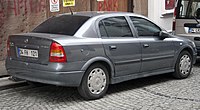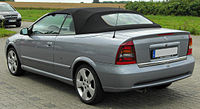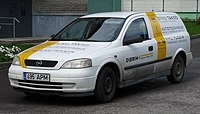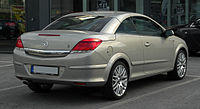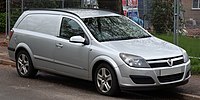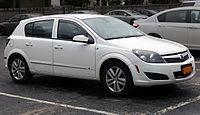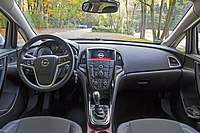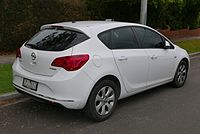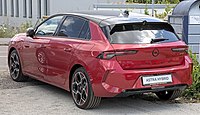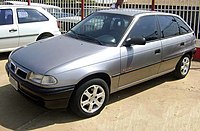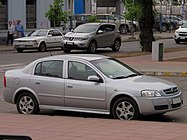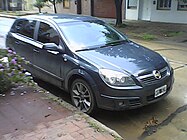Opel Astra
| Opel Astra | |
|---|---|
 | |
| Overview | |
| Manufacturer | Opel [a] |
| Also called |
|
| Production | 1991–present |
| Body and chassis | |
| Class | Compact car/small family car (C) |
| Layout | Front-engine, front-wheel drive |
| Chronology | |
| Predecessor | |
| Successor |
|
The Opel Astra is a compact car/small family car (C-segment) developed and produced by the German automaker Opel since 1991, currently at its sixth generation. It was first launched in September 1991 as a direct replacement to the Opel Kadett. As of 2021[update], the car slots between the smaller Corsa supermini and the larger Insignia large family car.
Initially, the Astra was available in hatchback, saloon, and estate (station wagon; known as the Astra Caravan, later the Sports Tourer) forms. A panel van (sedan delivery; Astravan) and a convertible (Astra Cabrio) also appeared in the early 1990s. These body styles were later followed by a coupé (the Astra GTC) in 2004, and the sporty Astra OPC appeared in 2005. The Twin Top retractable hardtop convertible replaced the soft top convertible in 2006, while the Caravan was renamed to Astra Sports Tourer since 2009.
The Astra is branded the Vauxhall Astra in the United Kingdom. It was rebadged and sold as the Saturn Astra in North America between 2008 and 2009, as the Buick Excelle XT from 2009 until 2015 and as the Buick Verano/Hatchback GS in China from 2015 until 2021. The Holden Astra was discontinued in Australia and New Zealand in 2009, and was replaced by the locally assembled Holden Cruze. It briefly returned to the Australian market in 2012, for the first time badged as an Opel,[1] but was discontinued after Opel withdrew from the country a year later.[2] In 2015, Opel reintroduced the Astra GTC and Astra VXR to Australia and New Zealand in 2015, again bearing the Holden badge. Between 2017 and 2019, the Astra nameplate was also used for the Holden version of the Cruze sedan.[3][4]
After Opel was sold by General Motors to PSA Group, the Astra K continued to be produced under license until it was replaced by the Astra L. The Astra L was released after the merger of the company to form Stellantis.[5][6][7]
The Astra nameplate originates from Vauxhall, which had manufactured and marketed earlier generations of the Opel Kadett (the Kadett D and Kadett E) as the Vauxhall Astra since March 1980. Subsequent GM Europe policy standardised model nomenclature in the early 1990s, whereby model names were the same in all markets regardless of the marque they were sold under.
As of 2021, there have been six generations of the Astra (or eleven generations of the Kadett/Astra family as a whole). In a fashion typical for Opel, they are designated with subsequent letters of the Latin alphabet. Opel's official convention is that the Astra is a logical continuation of the Kadett lineage, thus, the first generation of Opel Astra became the Astra F rather than the Astra A since the final Opel Kadett was the Kadett E. The Mk1 and Mk2 Vauxhall Astras are sometimes called the Astra D and Astra E by enthusiasts to mark the continuity with their sister models.
Models sold as Vauxhall, Holden, or Chevrolet have different generation designations reflecting the history of those nameplates in their home markets and their naming conventions.
First generation (Astra F – T91; 1991)
[edit]| First generation (Astra F) | |
|---|---|
 Pre-facelift Opel Astra Hatchback 5-door | |
| Overview | |
| Model code | T91 |
| Also called |
|
| Production | June 1991 – 2003 |
| Model years | September 1991–2003 |
| Assembly | Belgium: Antwerp Germany: Bochum Germany: Eisenach United Kingdom: Ellesmere Port (Vauxhall Ellesmere Port) Hungary: Szentgotthárd India: Halol (OIPL) Indonesia: Bekasi (GMBI)[8] Italy: Grugliasco (Bertone) Poland: Gliwice South Africa: Port Elizabeth (Delta Motor) Taiwan: Xinzhuang District (CAC) Thailand: Rayong (GM Thailand) |
| Designer | |
| Body and chassis | |
| Body style | 3 and 5-door hatchback 4-door sedan / saloon 5-door wagon / estate 2-door convertible 3-door sedan delivery (panel van) |
| Layout | GM T platform |
| Platform | T-body platform |
| Powertrain | |
| Engine | |
| Transmission | 5-speed manual 6-speed manual 4-speed automatic |
| Dimensions | |
| Wheelbase | 2,517 mm (99.1 in) |
| Length | Hatch: 4,050 mm (159.4 in) Sedan: 4,239 mm (166.9 in) Wagon: 4,278 mm (168.4 in) Convertible: 4,239 mm (166.9 in) |
| Width | 1,696 mm (66.8 in) |
| Height | 1,410 mm (55.5 in) |
The Astra F debuted in September 1991. With the Kadett E's successor, Opel adopted the Astra nameplate, which was already used by Vauxhall for the Kadett D and E (see Vauxhall Astra). It was offered as a three- or five-door hatchback, a saloon (sedan), and an estate (wagon) known as the Caravan and available with five doors only, bringing Opel's run of three-door wagons to an end at long last. The Caravan appeared in October 1991, immediately after the original introduction, as did the sporty, 16-valve GSI model with its aggressive bodykit.[9] A cabriolet was also offered, designed, and built by Bertone in Italy.
Compared to the Kadett, the Astra grew slightly in all dimensions except the wheelbase. The windshield was moved forward by 7.5 cm (3 in) while the roof was extended the same amount at the rear, meaning a significant increase in interior volume.[10]
The Astra F received a cosmetic facelift in the of 1994,[11] accompanied by improved rust protection. This included a new grille with a larger Opel badge, clear front turn signals, new door mirrors (replacing the earlier Kadett E units used on the pre-facelift model), and a generally smoothed-out appearance. While the Astra F finished production in Germany in 2000, Polish-built Astras remained on offer in Central and Eastern Europe, as well as Turkey, India and Asia with the name Opel Astra Classic from 1999 to 2003.[12]
The Astra F consisted of two main revisions and was revised in 1995, with the launch of Opel's new Ecotec engine.
Aside from the South Africa-only 200tS, the lead model was the GSi – a 2.0-litre 16V fuel injected model with 150 PS (110 kW), available as a three-door only. It also featured a sports body kit and widened front seats in the interior. However, this was substituted in 1995 and was renamed as SPORT, although only a limited number were produced and the body kit was removed also and it could be selected with the lower-powered, but more modern 'Ecotec' version, the 136 PS (100 kW; 134 bhp) X20XEV parallel with the C20XE. In Europe from 1994 all Astra models were offered with the 2.0 L 16V Ecotec X20XEV parallel with the eight-valve C20NE engine, but the three-door and station wagon models could be selected with the 150 PS (110 kW; 148 bhp) C20XE engine.
After the Astra F was replaced by the new generation Astra G in 1998, the so-called "REDTOP" C20XE engine was also taken out of production.
Gallery
[edit]-
Hatchback (facelift version)
-
The Astra GSi received a bodykit and alloy wheels
-
Sedan (pre-facelift)
-
Facelift version (Caravan)
-
Caravan (facelift)
-
Cabriolet
-
Interior (facelift)
South African models
[edit]The model was also launched in South Africa in November 1991, where it was produced under licence by Delta. The "Kadett" name was retained for the hatchback Astras until 2000. The sedan and station wagon models were offered under the Astra name. The Kadett and Astra in South Africa won the title of 'Car of the Year' in two consecutive years (1994 and 1995) even though they were versions of the same car.[13] South African nomenclature was denoted in centilitres, so the Astra and Kadett ranges featured 140, 160i, 180i and 200i models. Models with fuel injection received the "i" designation, while carburetor models didn't. Additional model designation was listed after the displacement with the inclusion of the letters "S" for sport or "E" for executive. Sport trim was typically for the Kadett (hatchback) model and included a different front bumper with spotlights and a rear spoiler. Executive derivatives included a higher specification level than non-executive models. The top variant in the Kadett (hatchback) model was the 200iS which featured a 2.0 SOHC 8v engine producing 95kw while the top spec Astra (sedan) derivative featured a 2.0 16v DOHC engine producing 110kw. The South African lineup also included a unique limited edition variant with a turbocharged C20LET engine called the 200tS offered in either Kadett (hatchback) or Astra (sedan) derivatives and was only available for two model years (1994-1995) and in limited numbers.[14] The 200tS was built by Delta Motor Corporation and faster than the then-current BMW M3 in a quarter-mile drag race.[citation needed] The "t" stands for the turbocharger. The engine was sourced from the 4x4 Opel Calibra and Opel Vectra and converted from a six-speed, four-wheel drive transmission (Getrag F28) to front-wheel drive only with a limited slip differential. The 200tS was unique from other Kadett and Astra models as it used a 5 bolt wheel hub (all other cars used a 4 bolt hub), it also featured unique 16" alloy wheels only available on the 200tS.
Other markets
[edit]The Opel Astra also became available in Australasia badged as a Holden, first in New Zealand in 1995, and then Australia in 1996. These models were imported from the UK. The Holden Astra name had previously been used on rebadged Nissan Pulsar models from 1984 to 1989.
The Opel Astra's first generation was exported to Brazil from December 1994 as the Chevrolet Astra, possibly because of a lowering of import tariffs. General Motors do Brasil sent the 2.0-litre, 115 bhp engines to Belgium, whence the completed cars took their way to Brazil. In February 1996 the Brazilian government again changed the import tariff, from 20 to 70% - making the car prohibitively expensive and leading to its cancellation after just over a year on the market.[15] Instead, the locally built Kadett was updated. The second-generation Astra was manufactured in Brazil.
Beginning in March 1995, the Astra sedan was assembled in Indonesia where it was marketed as the Opel Optima.[16] The renaming was done as the global name was already used by Astra International, a local automotive company and an assembler/distributor of several competing car brands. In India the Opel Astra was assembled for the local market in a joint venture with the Birla Companies, beginning in 1996.[17] Indian production ended in 2002.
The first-generation Chevrolet Astra in Brazil had a Vauxhall-style front grille featuring a "V", containing the Chevrolet badge.[18]
-
Vauxhall Astra Mk 3 (United Kingdom; pre-facelift)
-
Vauxhall Astra Mk 3 (United Kingdom; facelift)
-
Holden Astra TR (Australia and New Zealand)
Awards
[edit]- 1992 – Semperit Irish Car of the Year
- 1994 and 1995 – South African Car of the Year
Engines
[edit]| Petrol engine | |||||||
|---|---|---|---|---|---|---|---|
| Engine code | Engine | Displacement | Power | Torque | Fueling system | Valvetrain | Compression ratio |
| 140I | Inline-four | 1389 cc | 60 PS (44 kW; 59 hp) | 103 N⋅m (76 lb⋅ft) | Multi-point fuel injection | SOHC | 9.4:1 |
| 140IE | Inline-four | 1398 cc | 75 PS (55 kW; 74 hp) | 110 N⋅m (81 lb⋅ft) | Carburetor | SOHC | 9.4:1 |
| 140IS | Inline-four | 1398 cc | 82 PS (60 kW; 81 hp) | 115 N⋅m (85 lb⋅ft) | Multi-point fuel injection | SOHC | 9.8:1 |
| C14NZ | Inline-four | 1389 cc | 60 PS (44 kW; 59 hp) | 103 N⋅m (76 lb⋅ft) | Single-point fuel injection | SOHC | 9.4:1 |
| C14SE | Inline-four | 1389 cc | 82 PS (60 kW; 81 hp) | 113 N⋅m (83 lb⋅ft) | Multi-point fuel injection | SOHC | 10.0:1 |
| X14NZ | Inline-four | 1389 cc | 60 PS (44 kW; 59 hp) | 103 N⋅m (76 lb⋅ft) | Single-point fuel injection | SOHC | 9.4:1 |
| X14XE (Ecotec) | Inline-four | 1389 cc | 90 PS (66 kW; 89 hp) | 125 N⋅m (92 lb⋅ft) | Multi-point fuel injection | DOHC | 10.5:1 |
| C16NZ and X16SZR | Inline-four | 1598 cc | 75 PS (55 kW; 74 hp) | 125 N⋅m (92 lb⋅ft) | Single-point fuel injection | SOHC | 9.2:1 |
| C16SE | Inline-four | 1598 cc | 100 PS (74 kW; 99 hp) | 135 N⋅m (100 lb⋅ft) | Multi-point fuel injection | SOHC | 9.8:1 |
| X16SZ | Inline-four | 1598 cc | 71 PS (52 kW; 70 hp) | 128 N⋅m (94 lb⋅ft) | Single-point fuel injection | SOHC | 10.0:1 |
| X16XZR | Inline-four | 1598 cc | 71 PS (52 kW; 70 hp) | 128 N⋅m (94 lb⋅ft) | Single-point fuel injection | SOHC | 9.6:1 |
| X16XEL (Ecotec) | Inline-four | 1598 cc | 101 PS (74 kW; 100 hp) | 148 N⋅m (109 lb⋅ft) | Multi-point fuel injection | DOHC | 10.5:1 |
| C18NZ | Inline-four | 1796 cc | 90 PS (66 kW; 89 hp) | 145 N⋅m (107 lb⋅ft) | Single-point fuel injection | SOHC | 9.2:1 |
| C18XE | Inline-four | 1794 cc | 125 PS (92 kW; 123 hp) | 168 N⋅m (124 lb⋅ft) | Multi-point fuel injection | DOHC | 10.8:1 |
| C18SEL (Ecotec) | Inline-four | 1798 cc | 115 PS (85 kW; 113 hp) | 168 N⋅m (124 lb⋅ft) | Multi-point fuel injection | DOHC | 9.9:1 |
| C18XEL (Ecotec) | Inline-four | 1798 cc | 115 PS (85 kW; 113 hp) | 168 N⋅m (124 lb⋅ft) | Multi-point fuel injection | DOHC | 10.8:1 |
| X18XE (Ecotec) | Inline-four | 1794 cc | 115 PS (85 kW; 113 hp) | 170 N⋅m (125 lb⋅ft) | Multi-point fuel injection | DOHC | 10.8:1 |
| 20SEH (South Africa) | Inline-four | 1998 cc | 130 PS (96 kW; 128 hp) | 180 N⋅m (133 lb⋅ft) | Multi-point fuel injection | SOHC | 9.8:1 |
| 20XE-LN (South Africa) | Inline-four | 1998 cc | 156 PS (115 kW; 154 hp) | 200 N⋅m (148 lb⋅ft) | Multi-point fuel injection | DOHC | 9.8:1 |
| C20NE | Inline-four | 1998 cc | 115 PS (85 kW; 113 hp) | 170 N⋅m (125 lb⋅ft) | Multi-point fuel injection | SOHC | 9.2:1 |
| X20XEV (Ecotec) | Inline-four | 1998 cc | 136 PS (100 kW; 134 hp) | 185 N⋅m (136 lb⋅ft) | Multi-point fuel injection | DOHC | 10.8:1 |
| C20XE | Inline-four | 1998 cc | 150 PS (110 kW; 148 hp) | 196 N⋅m (145 lb⋅ft) | Multi-point fuel injection | DOHC | 10.5:1 |
| C20LET (South Africa) | Inline-four | 1998 cc | 204 PS (150 kW; 201 hp) | 280 N⋅m (207 lb⋅ft) | Multi-point fuel injection, turbocharger |
DOHC | 8.5:1 |
| Diesel engine | |||||||
| Engine code | Engine | Displacement | Power | Torque | Fueling system | Valvetrain | Compression ratio |
| 17D | Inline-four | 1699 cc | 57 PS (42 kW; 56 hp) | 105 N⋅m (77 lb⋅ft) | Bosch injection pump | SOHC | 23:1 |
| 17DR | Inline-four | 1699 cc | 60 PS (44 kW; 59 hp) | 105 N⋅m (77 lb⋅ft) | Bosch injection pump | SOHC | 23:1 |
| X17DTL | Inline-four | 1700 cc | 68 PS (50 kW; 67 hp) | 132 N⋅m (97 lb⋅ft) | Bosch injection pump | SOHC | 22:1 |
| X17DT | Inline-four | 1686 cc | 82 PS (60 kW; 81 hp) | 168 N⋅m (124 lb⋅ft) | Bosch injection pump | SOHC | 22:1 |
| Electric engine | |||||||
| Engine code | Engine | Accumulator capacity | Power | Torque | Accumulator type | ||
| Impuls 2 | Electric | 80 km | 60 PS (44 kW; 59 hp) | N/A | NiCd | ||
| Impuls 3 | Electric | 140 km | 57 PS (42 kW; 56 hp) | N/A | NaNiCl | ||
Second generation (Astra G – T98; 1998)
[edit]| Second generation (Astra G) | |
|---|---|
 Opel Astra G Hatchback 5-door (facelift; front) | |
| Overview | |
| Model code | T98 |
| Also called |
|
| Production | 1998–2004 (Opel) 1998–2011 (Chevrolet) September 1999 – May 2004 (Ireland) |
| Assembly | Belgium: Antwerp Brazil: São Caetano do Sul (GM do Brasil) Egypt: 6th of October City (GME) Germany: Bochum Italy: Grugliasco (Bertone)[19] Poland: Gliwice Russia: Tolyatti (GM-AvtoVAZ) South Africa: Port Elizabeth (Delta Motor)[20] Ukraine: Zaporizhzhia (AvtoZAZ)[21] United Kingdom: Ellesmere Port |
| Designer | |
| Body and chassis | |
| Class | Small family car (C) |
| Body style | 3/5-door hatchback 4-door saloon 5-door estate 2-door cabriolet 2-door coupé 3-door car derived van |
| Layout | GM T platform |
| Platform | T-body platform |
| Related | Opel Zafira A |
| Powertrain | |
| Engine |
|
| Transmission | 5-speed manual 4-speed automatic 5-speed automatic |
| Dimensions | |
| Wheelbase | 2,606 mm (102.6 in) Wagon: 2,611 mm (102.8 in) |
| Length | Hatch: 4,110 mm (161.8 in) Saloon: 4,252 mm (167.4 in) Estate: 4,288 mm (168.8 in) Convertible: 4,267 mm (168.0 in) |
| Width | 1,709 mm (67.3 in) |
| Height | 1,425 mm (56.1 in) Cabriolet: 1,390 mm (54.7 in) |
The Astra G was launched in Europe in Spring of 1998. It was available as a three or five-door hatchback, four-door saloon, five-door estate (in Opel tradition, known as a "Caravan") and two special versions from 2000: the Astra Coupé and the Astra Cabrio, both of them designed and built by Bertone.[22] The Astra G saw the introduction of a natural gas-powered engine. Its chassis was tuned by Lotus and formed the base of a 7-seater compact MPV, the Opel Zafira, which was co-developed by Porsche. Approximately 90,000 coupés were produced.
The manufacturing of the Astra saloon and Caravan continued at Opel's Gliwice plant in Poland after the debut of the next-generation Astra H, with the older model being branded as Astra Classic in a similar fashion to its predecessor, catering to the lower end of the market. This car was offered in Central and Eastern Europe, as well as Turkey with the name Astra Classic II from 2004 to the end of 2009. Apart from European markets, these models were also sold in Australia and New Zealand as the Holden Astra Classic, until they were replaced by the Holden Viva (built-in South Korea) in 2006.
The Astra G was built as Chevrolet Astra in Brazil. It was facelifted in 2003 and was sold in Brazil, Argentina, Mexico, and other Latin American markets until 2011. The GM Brazilian 2.0 8V inline-four engine which equips the Astra has the "flex-power" technology, that allows the car to run on both petrol and alcohol fuels, providing 128/140 hp (G/A) at 5200 rpm.
A taxi version of the Brazilian sourced model, powered with petrol 2.0-litre engine was sold in Chile as the Chevy Urban.[23][24]
In 2004, GM's Russian joint venture GM-AvtoVAZ launched the 4-door version of the Astra G as the Chevrolet Viva. It was sold through Chevrolet dealers in Russia, while Opel dealers were selling the newer Opel Astra H. Sales were poor from the start due to high pricing: the only version launched was equipped with a 1.8L engine with an above-average trim level, placing the Viva's price above the Toyota Corolla.[25] A project costing $340 million was selling less than a thousand cars annually (801 cars in 2007);[25][26] rumours of shutting down Chevy Viva production circulated as early as summer of 2005.[27] GM-AvtoVAZ shut down small-scale production of the Viva in March 2008.[25]
Gallery
[edit]-
3-door
-
5-door
-
Coupé
-
Astravan
-
Opel Astra G OPC
Markets
[edit]-
Vauxhall Astra Mk4 (United Kingdom)
-
Holden Astra TS (Australia and New Zealand)
-
Chevrolet Viva (Russia)
V8 Coupe in DTM
[edit]The Astra G series Coupé was used for the silhouette racing cars in the DTM series. These DTM racing cars are purpose-built race cars with barely any parts taken from the road cars except for lights and door handles. The car's bodywork featured gull-wing doors that were each supported by two gas struts. The racing cars were powered by 4.0L V8 engines with nearly 500 hp (370 kW). Opel did poorly during several seasons of DTM as only Manuel Reuter placed significantly in the championship once, taking second in the inaugural season in 2000 before withdrawing at the end of 2005, but the car was also used to win the 24h Nürburgring in 2003.
Xtreme
[edit]The Astra Xtreme, a concept car presented at the 2001 Geneva motor show, was a single-production V8-powered Astra based on the G-series Astra DTM. Like the DTM racing car, it featured a 4.0 litres (240 cu in) V8 engine, producing 444 hp (331 kW), gull-wing doors supported by gas struts, carbon fibre panels, and race-specification interior with five-point seatbelts.
Gallery
[edit]-
Opel Astra G OPC Xtreme
-
Rear view
Stock Car Brazil
[edit]The season of 2005 also joined the history of Stock Car. In addition to the category becoming multi - the first time the Mitsubishi Lancer ran alongside the Chevrolet Astra, on 30 October 2005, 40 cars with Stock Car V8 engines performed an unprecedented race outside of Brazil worth points for the championship. It was a round to the side of TC 2000, the main category of Argentina and in July had run in Curitiba (Autodromo Internacional de Curitiba). The Autódromo Juan y Oscar Gálvez got a crowd of 70,000 people. Giuliano Losacco was the winner, with Mateus Greipel second and Luciano Burti third.
The engine was a V8 Chevrolet 350 imported from the United States by JL, similar to that used in Busch Series, the second category of NASCAR, equal and limited to 450 hp (336 kW). The automaker GM was now sponsoring the category, providing the fairing of the Astra, making room for other manufacturers to enter the category with a low investment.
Safety
[edit]| Test | Score | Rating |
|---|---|---|
| Adult occupant: | 25 | |
| Pedestrian: | 7 |
Third generation (Astra H – A04; 2004)
[edit]| Third generation (Astra H) | |
|---|---|
 Opel Astra H 5-door (front, pre-facelift) | |
| Overview | |
| Model code | A04 |
| Also called |
|
| Production | 2004–2010 (Opel)[29][30] October 2005–2011 (Chevrolet) 2008–2009 (Saturn) |
| Assembly | Belgium: Antwerp (Opel's Antwerp Plant) Brazil: São Caetano do Sul (GM do Brasil) Egypt: 6th of October City (GME)[31] Germany: Bochum Poland: Gliwice Russia: Kaliningrad (Avtotor) Russia: St. Petersburg (2008–2009) Ukraine: Zaporizhzhia (AvtoZAZ)[32] United Kingdom: Ellesmere Port |
| Designer | Friedhelm Engler[33] |
| Body and chassis | |
| Body style | 3-door hatchback coupé (GTC) 5-door hatchback 4-door sedan / saloon 5-door wagon / estate 2-door convertible (TwinTop) 3-door sedan delivery (panel van) |
| Layout | GM T platform |
| Platform | T platform[34][35] |
| Related | Opel Zafira B |
| Powertrain | |
| Engine | |
| Transmission | 5-speed F17 manual 6-speed manual 5-speed Easytronic automated manual 4-speed Aisin 60-40LE automatic 6-speed automatic |
| Dimensions | |
| Wheelbase | 2,614 mm (102.9 in) (hatchback and TwinTop) 2,703 mm (106.4 in) (saloon and estate) |
| Length | 5-door hatch: 4,249 mm (167.3 in) 3-door GTC: 4,288 mm (168.8 in) Sedan: 4,587 mm (180.6 in) Wagon: 4,515 mm (177.8 in) TwinTop: 4,476 mm (176.2 in) |
| Width | 1,753 mm (69.0 in) 1,759 mm (69.3 in) (TwinTop) |
| Height | 5-door hatch: 1,467 mm (57.8 in) 3-door GTC: 1,415 mm (55.7 in) Sedan: 1,458 mm (57.4 in) Wagon: 1,500 mm (59.1 in) TwinTop: 1,411 mm (55.6 in) |
| Chronology | |
| Predecessor | Saturn Ion (US) |
| Successor | Chevrolet Cruze (Chile and Mexico) Buick Verano (Saturn Astra) Opel Combo (Astravan) Opel Cascada (TwinTop) |
The Astra H was launched in March 2004 as a five-door hatchback, whilst a five-door estate launched late 2004 and a sporty three-door hatchback, designated the GTC (Gran Tourismo Compact) for European markets, Sport Hatch in the UK and the Coupé in Australia, launched in 2005. The GTC has the option of a windscreen called "panoramic windscreen" (unique for a production car at the time of its launch) which extends into the roof area. Based on an updated version of GM's T platform, its size was increased compared to the previous version. Production came until the end of 2009, excepting the TwinTop which continued to be manufactured until November 2010.
The ageing Vectra B was replaced in Brazil with a sedan version of the Astra H, named Chevrolet Vectra, until it was replaced by the Chevrolet Cruze in 2009. The model was matched with the other models offered in Brazil. This version was offered as an Opel in some Eurasian markets in 2006, following a debut at the international auto show in Istanbul, Turkey, including Ireland in 2008.[36] This was manufactured in Gliwice, Poland.[37] Also in 2006, the Astravan, a 3-door van variant of the estate, was launched. In September 2007, a version of the 5-door Astra was launched in Brazil, marketed as Chevrolet Vectra GT to differentiate from the already existing Astra, which was replaced by the Chevrolet Cruze hatchback in 2011.
The Opel Astra was revised in January 2007, with the introduction of different colours of the posterior lighthouses and a new front.
GM Russia launched SKD assembly of Astra on a temporary production site near Saint Petersburg in February 2008, with a potential capacity of 25,000 vehicles annually.[38]
The Chevrolet Astra was withdrawn from Mexico in 2008 as a result of the withdrawal of Opel products from the brand, replaced by the Chevrolet Cruze sedan for the 2010 model year.
A first for any major European car is the availability of digital radio on some versions of the new Astra, while for the Astra product class first are electronically controlled chassis (IDS+) and AFL (Adaptive Forward Lighting).
This generation was kept in production in Bochum alongside the new Astra J and sold as the Opel Astra Classic III in some Eastern European markets such as Poland and Turkey. It was available as a 5-door hatchback, saloon, and estate.[citation needed] Production of the Opel Astra Classic III eventually ended in 2014.
At the end of 2012, the Astravan was replaced by the new Opel Combo D (where the production of the Astra H had already ended).
Pre-facelift
[edit]-
Opel Astra H 5-door (rear, pre-facelift)
-
Opel Astra H Caravan (rear, pre-facelift)
-
Interior
Facelift
[edit]-
Opel Astra 5-door (front, post-facelift)
-
Opel Astra 5-door (rear, post-facelift)
-
Opel Astra H Caravan (rear, post-facelift)
-
Opel Astra H GTC (front, post-facelift)
-
Opel Astra H GTC (rear, post-facelift)
-
Opel Astra sedan (rear, post-facelift)
OPC
[edit]During 2005, Opel introduced the OPC version of the Astra GTC (sold as the Astra VXR in the UK) which is powered by an updated version of the 2.0 L turbo Family II engine (Z20 LEH) producing 240 PS (177 kW, 237 bhp) and 320 N⋅m (236 lb⋅ft) of torque. Standard features of the OPC version include sports bodykit and recaro interior, a six-speed manual gearbox, xenon headlamps and 18-inch alloy wheels amongst others.
This vehicle was sold until late 2009 in Australia and New Zealand by Holden Special Vehicles as the HSV VXR. HSV VXRs but it never offered a sedan in the UK and Australia are sold as standard with full leather trim, climate control, 6 disc CD and 19-inch alloy wheels. HSV VXRs were badged as per the UK Vauxhall Spec models but without the usual rear boot badge. The sedan was discontinued in Australia and United Kingdom in 2007. Inside the Opel Blitz appears on the steering wheel with an OPC dashboard. The Astra OPC was also sold as the Chevrolet Astra OPC in Chile.
Gallery
[edit]-
Opel Astra OPC Nürburgring Edition (2008)
-
Opel Astra OPC Race Camp (2009)
TwinTop
[edit]In 2006, the Astra TwinTop arrived. (The "TwinTop" name also applies to the smaller Tigra and refers to a retractable hardtop convertible version of the car, shared with the Pontiac G6.) The Astra TwinTop has a three-part folding metal roof which sits in the upper half of the boot space, leaving considerable luggage space below it. Still marketed as a four-seater, the rear seating space is smaller than other Astra models. The TwinTop was available in three trim levels with a range of engines in each, including a 200 PS (147 kW; 197 hp) 2.0 L turbo and the 1.9 CDTI diesel in 150 PS (110 kW; 148 hp) form.
Launched in January 2007, Australian-market TwinTops came with the Z22YH 2.2 L direct-injection engine with a choice of 6-speed manual or 4-speed automatic transmission which was unique to Australia.[39][40]
The folding roof assembly was built by Magna Steyr's Car Top Systems (CTS) subsidiary in Antwerp, Belgium, near the plant where the TwinTop was assembled.[41] The TwinTop was discontinued in November 2010 along with the 3-door GTC, both replaced by the soft-top Opel Cascada.
Gallery
[edit]-
Opel Astra TwinTop
-
Opel Astra TwinTop (2007–2010)
Markets
[edit]-
Vauxhall Astra Mk5 (United Kingdom)
-
Vauxhall Astravan (MK5 United Kingdom)
-
Holden Astra AH 5 door (Australia)
Stock Car Brazil
[edit]In Brazil, Chevrolet Vectra (Astra H) substituted the Chevrolet Astra on Stock Car. The V8 is still the same, apart from that now they use Ethanol instead of Petrol.
Saturn Astra
[edit]-
Saturn Astra XE 5-door
-
Saturn Astra XE 5-door (Rear)
-
Saturn Astra 3-door
-
Saturn Astra 3-door (Rear)
The Saturn Astra was marketed in North America both the U.S and Canada after debuting at the 2007 Chicago Auto Show.[42][43] Superseding the Ion, the Astra was a captive import, based on the Opel Astra, manufactured in Antwerp, Belgium.[44]
Available in three and five-door hatchback body styles, sales began on 2 January 2008 with a single engine, a 1.8 L U18XER inline-4-cylinder petrol engine with variable-valve technology producing 138 hp (103 kW) — available five-speed manual transmission or a four-speed automatic transmission.
The XE base trim level was offered on the five-door hatchback and included steel wheels with plastic covers.[45] The XR trim level was the only trim level for the 3-door and was available on five-door models — and included enhanced seat bolsters, driver lumbar and seat height adjusters; 17-inch alloy ten-spoke wheels and P225/45R17 all-season performance tires; easy Entry front sliding seats (3 door model) and enhanced instrument gauges.
Standard equipment included air conditioning (XR trim); cruise control; driver information centre including audio, time and outside temperature display; power door locks with central locking feature and remote keyless entry; courtesy lighting and dual reading lamps in front and rear; cloth front bucket reclining seats with adjustable active head restraints; easy entry front sliding seats (3 door); rear 60/40-split flat-folding seat with adjustable and removable head restraints and retractable; dual cupholders, driver 4-way and passenger 2-way manually adjustable seats; three-spoke steering wheel with rake and telescoping steering column; steering wheel-mounted audio and Driver Information Center controls; overhead sunglass storage; front seat illuminated vanity mirrors; power windows with express-Down; front console with cupholder and 12-volt power outlet; power-adjustable, manual folding, heated side mirrors; and rain sensing front intermittent windshield wipers.
An optional Premium Trim Package for XR models included leather seating surfaces, vinyl door trim, leather-wrapped steering wheel, driver manual lumbar seat adjuster, heated front seats, and interior ambient LED lighting. For 2008, an optional Sport Handling Package included stability control (marketed as StabiliTrak), lowered sport suspension, and quick-ratio power steering. This package was made standard on the 2009 3-door. A panoramic sunroof was available on 5-door models.
In Insurance Institute for Highway Safety (IIHS) crash tests the Astra earned a Good overall score in frontal impacts, while in side impacts it received a Marginal overall rating. Front and rear head curtain airbags and front seat-mounted torso airbags were standard,[46] along with a system marketed as the Pedal Release System, whereby the clutch and or brake pedal would decouple in the event of a frontal crash with significant cowl intrusion, mitigating lower leg injury.
General Motors predicted sales of between 30,000 and 40,000 vehicles a year in the United States. Sales were slow, due initially to a large glut of unsold Ions and later the uncertainty surrounding the Saturn brand's future. In 2008 only 11,968 were sold in the US[47] and in 2009 this fell to 6,298. In Canada the sales of the Saturn Astra was up to 11,605 in total between 2007 and 2010.[48]
With a large number of unsold cars remaining on dealer lots, GM announced it would end import of the Astra.[49] In June 2009, GM announced its intention to sell the Saturn Corporation to Penske Automotive Group. This never was concluded and in 2010 General Motors discontinued the Saturn brand.
The successor to the Saturn Astra in the North American General Motors lineup was the Buick Verano, introduced for the 2012 model year. The Verano is derived from the succeeding Astra J.
Engines
[edit]Engines were available with 5- and 6-speed manual transmission, Easytronic automated manual gearbox with 5-speeds, and also 4- and 6-speed automatic transmission. In the beginning there were petrol 1.4 90 PS, 1.6 105 PS, 1.8 125 PS and new 2.0 Turbo engine with two versions: 170 PS and 200 PS. Diesel lineup were 1.3 CDTI with 90 PS, 1.7 CDTI with 80 PS, 100 PS, and 1.9 CDTI engines with 120 and 150 PS. During production some engine got more power like 1.6, 1.8, 1.7, 1.9 and 2.0 Turbo with 240 PS was introduced in 2005 in OPC/VXR version. 1.3 CDTI 90 PS was introduced in 2005 and he replaces 1.7 CDTI with 80 PS.
After restyle at end of 2006 / beginning of 2007, new engines were introduced: 1.6 Turbo engine with 180 PS which replace 2.0 Turbo with 170, and 1.7 CDTI with 125 PS.
| Petrol engine | |||||||
|---|---|---|---|---|---|---|---|
| Engine code | Engine | Displacement | Power | Torque | Note | CO2 emission (g/km) | Years |
| Z14XEL | I4 | 1364 cc | 75 PS (55 kW; 74 hp) at 5200 rpm | 120 N⋅m (89 lb⋅ft) at 3800 rpm | Austria only | 151 | 2004–2010 |
| Z14XEP | 90 PS (66 kW; 89 hp) at 5600 rpm | 125 N⋅m (92 lb⋅ft) at 4000 rpm | 146 | ||||
| Z16XEP | 1598 cc | 105 PS (77 kW; 104 hp) at 6000 rpm | 150 N⋅m (111 lb⋅ft) at 3900 rpm | 146 | 2004–2007 | ||
| Z16XER | 115 PS (85 kW; 113 hp) at 5500 rpm | 155 N⋅m (114 lb⋅ft) at 4000 rpm | 155 | 2006–2014 | |||
| Z16LET | 180 PS (132 kW; 178 hp) at 5500 rpm | 230 N⋅m (170 lb⋅ft) at 1980–5500 rpm | turbocharged | 185 | 2006–2010 | ||
| Z18XE | 1796 cc | 125 PS (92 kW; 123 hp) at 5600 rpm | 170 N⋅m (125 lb⋅ft) at 3800 rpm | 185 | 2004–2006 | ||
| Z18XER | 140 PS (103 kW; 138 hp) at 6300 rpm | 175 N⋅m (129 lb⋅ft) at 3800 rpm | 169 | 2006–2010 | |||
| Z20LEL | 1998 cc | 170 PS (125 kW; 168 hp) at 5200 rpm | 250 N⋅m (184 lb⋅ft) at 1950–4000 rpm | turbocharged | 216 | 2004–2006 | |
| Z20LER | 200 PS (147 kW; 197 hp) at 5400 rpm | 262 N⋅m (193 lb⋅ft) at 4200 rpm | 223 | 2004–2010 | |||
| Z20LEH | 240 PS (177 kW; 237 hp) at 5600 rpm | 320 N⋅m (236 lb⋅ft) at 2400–5600 rpm | VXR, OPC | 221 | 2005–2010 | ||
| Diesel engine | |||||||
| Model | Engine | Displacement | Power | Torque | Note | CO2 emission (g/km) | Years |
| 1.3 CDTI | I4 | 1248 cc | 90 PS (66 kW; 89 hp) at 3800 rpm | 200 N⋅m (148 lb⋅ft) at 1700–2500 rpm | 109 | 2005–2009 | |
| 1.7 CDTI | 1686 cc | 80 PS (59 kW; 79 hp) at 3800 rpm | 170 N⋅m (125 lb⋅ft) at 1700–2500 rpm | 119 | 2004–2005 | ||
| 100 PS (74 kW; 99 hp) at 4000 rpm | 240 N⋅m (177 lb⋅ft) at 2300 rpm | 138 | 2004–2010 | ||||
| 110 PS (81 kW; 108 hp) at 4000 rpm | 260 N⋅m (192 lb⋅ft) at 2300 rpm | 138 | 2007–2014 | ||||
| 125 PS (92 kW; 123 hp) at 4000 rpm | 280 N⋅m (207 lb⋅ft) at 2300 rpm | 0-100km/h for caravan. Auto: 10.5s; manual 9.8s with sport button | 146 | 2007–2014 | |||
| 1.9 CDTI | 1910 cc | 100 PS (74 kW; 99 hp) at 3500 rpm | 260 N⋅m (192 lb⋅ft) at 1700–2500rpm | 154 | 2005–2009 | ||
| 120 PS (88 kW; 118 hp) at 4000 rpm | 280 N⋅m (207 lb⋅ft) at 2000–2750rpm | 159 | 2004–2009 | ||||
| 150 PS (110 kW; 148 hp) at 4000 rpm | 320 N⋅m (236 lb⋅ft) at 2000-2750 rpm | 159 | 2004–2009 | ||||
Safety
[edit]| Test | Score | Rating |
|---|---|---|
| Adult occupant: | 34 | |
| Child occupant: | 39 | |
| Pedestrian: | 3 |
Fourth generation (Astra J – P09; 2009)
[edit]| Fourth generation (Astra J) | |
|---|---|
 Opel Astra J Hatchback pre-facelift (front; 5-door) | |
| Overview | |
| Model code | P09 |
| Also called | Vauxhall Astra (United Kingdom) Holden Astra (Australia and New Zealand) Opel GTC (3 door, 2015–2018) Vauxhall GTC (3 door, 2015–2018) Buick Excelle XT (China) |
| Production | 2009–2015 2012–2018 (GTC and saloon) |
| Assembly | Germany: Rüsselsheim (Opel Automobile GmbH) Poland: Gliwice United Kingdom: Ellesmere Port China: Yantai (SAIC-GM) Russia: St. Petersburg (GM Auto LLC) |
| Designer | Uwe Müller[51] |
| Body and chassis | |
| Body style | 3-door hatchback coupé (GTC) 5-door hatchback 4-door sedan / saloon 5-door wagon / estate (Sports Tourer) |
| Layout | GM T platform |
| Platform | Delta II platform |
| Related | Buick Verano Chevrolet Cruze Opel Cascada Opel Zafira Tourer C Vauxhall Astra |
| Powertrain | |
| Engine | |
| Transmission | 5-speed manual 6-speed manual 6-speed automatic |
| Dimensions | |
| Wheelbase | 2,685 mm (105.7 in) 3-door GTC: 2,695 mm (106.1 in) |
| Length | 5-door hatch: 4,419 mm (174.0 in) 3-door GTC: 4,466 mm (175.8 in) Sedan: 4,658 mm (183.4 in) Wagon: 4,698 mm (185.0 in) |
| Width | 1,814 mm (71.4 in) 3-door GTC: 1,840 mm (72.4 in) |
| Height | 5-door hatch: 1,510 mm (59.4 in) 3-door GTC: 1,482 mm (58.3 in) Sedan: 1,500 mm (59.1 in) Wagon: 1,535 mm (60.4 in) |
The Astra J is based on the General Motors' Delta II platform, debuted at the 2009 Frankfurt Motor Show in Germany and went on sale in November 2009 as a 2010 model while the 2009 model year was entirely skipped.[52][53] The car has taken most of its styling from the new Opel Insignia, with many of the higher options fitted as standard. Full production came on line at Vauxhall's Ellesmere Port Plant at the end of September 2009. Deliveries began in December 2009. Referred to as the "Astra I", it officially received the "Astra J" name instead to avoid confusing the letter I for the number 1.[54]
The Astra was developed at Opel's 'International Technical Development Center' (ITDC) in Rüsselsheim and continues Opel's design language, ‘sculptural artistry meets German precision’ first introduced on the Insignia. The Astra features a torsion beam rear suspension with Watt's link.[55] Infotainment and car navigation systems are supplied by Bosch.[56][57]
The Opel Astra came third in the European Car of the Year award in 2010.
The station wagon version of the Astra - dubbed the 'Sports Tourer' by Opel, debuted at the 2010 Paris Motor Show, and went on sale shortly afterwards, with a starting price of £16,575 for the ES version, then Exclusiv, SRI and SE versions, with the SE costing from £20,345. This is cheaper than the previous estate, but has more standard equipment. The adoption of the "Sports Tourer" name finally brought to an end Opel's traditional "Caravan" designation for its station wagon derivatives.
The pre-facelift Astra J was briefly sold in Australia under the Opel brand, with its introduction into the Australian market in 2012. However, the Opel brand and nameplate subsequently pulled out of the Australian market in 2013 due to poor sales, and later versions of the Astra J, namely the OPC and GTC variant, were sold under the Holden brand name from 2013 onwards.
Shanghai GM launched the Chinese version of the Opel Astra hatchback, which is badged as the Buick Excelle XT. This car went on sale in January 2010. Three engines were announced: Ecotec D-VVT 1.6 L, 1.8 L and 1.6 L Turbo.
The saloon version of the Astra was first presented at the 2012 Moscow International Automobile Salon. The 4-door saloon has a number of names depending on market: Buick Excelle GT in China, Buick Verano in North America and Opel Astra sedan/saloon elsewhere. This version is not sold in the United Kingdom, although it is available in some other right hand drive markets, such as Ireland (as the: Astra Saloon),[58] Malta,[59] and South Africa.[60] Production for the saloon version continued until 2018 after the Astra K was released to supply several markets where saloons are popular, including Turkey.
Gallery
[edit]-
5-door hatchback
-
Sports Tourer
-
4-door saloon
-
Interior
GTC
[edit]A 3-door version dubbed Astra GTC was introduced in July 2011.[61] Externally, it retains very few design elements of the old 5-door model. It has a sportier appearance, with a much more 'sculpted' chassis. It features a HiPerStrut front suspension from the Opel Insignia OPC which helps alleviate torque steering. A Watt's linkage is present in the rear suspension, to minimize lateral movement of the axle. The wheelbase is enhanced to accommodate wider low-profile tyres. Similarly to the Astra H GTC, a 'panoramic windscreen' option is available. The Astra GTC was awarded a 5 star rating for its performance under Euro NCAP safety tests. In late 2013, a new 1.6 Turbo EcoTec engine with 200PS output replaced the older 180PS engine of the same capacity, meaning the 1.6 Turbo replaces the BiTurbo Diesel as the fastest non-OPC model in the range.
The GTC is built in Gliwice, Poland, with a range of models & petrol and diesel engines. In the UK, the GTC includes the SRi and VXR models.[62] Production continued alongside the Astra K when it was introduced in 2015, and concurrently dropped the Astra moniker for simply GTC.[63] In 2018, the model was discontinued.[64]
Models and colours
[edit]There are three models of the GTC, Sport, the SRi, Limited Edition, and the VXR model. Available colours are Power red (Solid), the Brilliant colours are Summit white & Flaming yellow, The Metallic colours are Granite grey, Deep sky blue, Carbon flash, Sovereign silver & Flip chip silver, The Pearlescent colours are Emerald green & Asteroid grey. The VXR also has Flash blue.[65]
Gallery
[edit]-
Opel Astra J GTC
-
Opel Astra J GTC
-
Vauxhall Astra Mk6 GTC
-
Holden Astra GTC
OPC
[edit]The OPC trim of the Astra GTC has been available since 2012. This car features a turbocharged 2.0 L direct injection engine with a power of 206 kW (280 PS; 276 hp) and torque of 400 N⋅m (295 lbf⋅ft), HiPerStrut front suspension, a mechanical limited slip differential, an electronically controlled FlexRide active suspension, and Recaro-style sport seats, OPC badge on gear knob, steering wheel, and on instrument dials and different and distinctive front and rear bumper, rear standard spoiler as well as optional OPC spoiler compared to GTC version. It comes with 19 inch alloy rims as standard and optional 20-inch alloy rims which are lighter than those 19-inch. The 0 to 100 km/h (62 mph) time is 6 seconds and top speed is limited to 250 km/h (155 mph).[66]
Gallery
[edit]-
Opel Astra J OPC
-
Rear view
-
Vauxhall Astra VXR for UK market
-
Holden Astra VXR (Australia)
Astravan
[edit]This generation Astra was not available as the commercial version Astravan. But in The Netherlands, the Astra Sports Tourer was available as Astravan at special order.
Engines
[edit]Engines are available with the 5-speed or 6-speed manual transmission. The only optional available automatic transmission is the 6-speed with active select mode, which can be ordered for the 1.4 turbo, 1.6, 1.6 turbo and 2.0 CDTI depending on region. From 2011, Start/Stop was introduced in certain countries on some models, and from 2012 an overboost function was added to the 1.4 turbo. [Engines with (S/S) are in bold in CO2 column]. The engines are Family 0/Family 1/Ecotec/MGE (petrol), and MultiJet/Circle L/GM MDE (diesel).
In February 2014, Opel introduced its all-new engine - GM Medium Diesel engine, the so-called "whisper diesel" 1.6 CDTI engine with 136 PS, and later with 110 PS.[67]
| Petrol engine | |||||||
|---|---|---|---|---|---|---|---|
| Model | Engine | Displacement | Power | Torque | Note | CO2 emission (g/km) | Years |
| 1.4 VVT | I4 | 1398 cc | 87 PS (64 kW; 86 hp) at 6000 rpm | 130 N⋅m (96 lb⋅ft) at 4000 rpm | 129 | ||
| 100 PS (74 kW; 99 hp) at 6000 rpm | |||||||
| 1.4 Turbo VVT | 1364 cc | 120 PS (88 kW; 118 hp) at 4200 rpm | 200 N⋅m (148 lb⋅ft) at 1850–4200 rpm | 138 | |||
| 140 PS (103 kW; 138 hp) at 4900 rpm | 200 N⋅m (148 lb⋅ft) at 1850–4900 rpm | ||||||
| 1.6 VVT | 1598 cc | 115 PS (85 kW; 113 hp) at 6000 rpm | 155 N⋅m (114 lb⋅ft) at 4000 rpm | 147 | |||
| 1.6 Turbo VVT | 180 PS (132 kW; 178 hp) at 5500 rpm | 230 N⋅m (170 lb⋅ft) at 2200–5400 rpm | 168 | ||||
| 1.6 Turbo SIDI | 1598 cc | 170 PS (125 kW; 168 hp) at 6000 rpm | 260 N⋅m (192 lb⋅ft) (overboost 280 (207)) at 1650–4250 rpm | 144 | 2013– | ||
| 200 PS (147 kW; 197 hp) at 5500 rpm | 280 N⋅m (207 lb⋅ft) (overboost 300 (221)) at 1650–3500 rpm | GTC | 154 | 2014– | |||
| 1.8 VVT | 1796 cc | 140 PS (103 kW; 138 hp) at 6300 rpm | 175 N⋅m (129 lb⋅ft) at 3800 rpm | Russia & China | 159 | ||
| 2.0 Turbo | 1998 cc | 280 PS (206 kW; 276 hp) at 5500 rpm | 400 N⋅m (295 lb⋅ft) at 2400–4500 rpm | OPC/VXR | 189 | 2012– | |
| Diesel engine | |||||||
| Model | Engine | Displacement | Power | Torque | Note | CO2 emission (g/km) | Years |
| 1.3 CDTI ecoFLEX | I4 | 1248 cc | 95 PS (70 kW; 94 hp) at 4000 rpm | 190 N⋅m (140 lb⋅ft) at 1750–3250 rpm | 109 (2009–) 104 (2011–) |
2009-'14 | |
| 1.6 CDTI ecoFLEX | 1598 cc | 110 PS (81 kW; 108 hp) at 3500 rpm | 300 N⋅m (221 lb⋅ft) at 1750–2500 rpm | 97 | 2014– | ||
| 136 PS (100 kW; 134 hp) at 3500–4000 rpm | 320 N⋅m (236 lb⋅ft) at 2000–2500 rpm | 104 | 2014– | ||||
| 1.7 CDTI ecoFLEX | 1686 cc | 110 PS (81 kW; 108 hp) at 3800 rpm | 260 N⋅m (192 lb⋅ft) at 1700–2500 rpm | 119 (2009–) 99 (2011–) |
2009–'14 | ||
| 125 PS (92 kW; 123 hp) at 4000 rpm | 280 N⋅m (207 lb⋅ft) at 2000–2700 rpm | 119 | 2009–'11 | ||||
| 130 PS (96 kW; 128 hp) at 4000 rpm | 300 N⋅m (221 lb⋅ft) at 2000–2500 rpm | 99-123 | 2011–'14 | ||||
| 2.0 CDTI | 1956 cc | 160 PS (118 kW; 158 hp) at 4000 rpm | 350 N⋅m (258 lb⋅ft) at 1750–2500 rpm | 129 | 2009–'11 | ||
| 165 PS (121 kW; 163 hp) at 4000 rpm | 119 | 2011– | |||||
| 2.0 CDTI BiTurbo | 195 PS (143 kW; 192 hp) at 4000 rpm | 400 N⋅m (295 lb⋅ft) at 1750–2500 rpm | 134 | 2013– | |||
Facelift
[edit]In June 2012, a facelift was announced. Visual changes occurred at the front and back of the hatchback and sports tourer. This included revised bumpers and grills and very minor changes to the headlights. The rear lights were also revised, and had an overall darker appearance, the registration-plate recess of the five-door model was re-designed, and the Sports Tourer (estate body) and 5-door hatchback model received new-style bumpers with chrome trim. New colours were introduced, such as Sculpture Bronze, Phantom Grey and Deep Sky metallic, plus others which were available as extra-cost options. The updated Astra also received some assistance systems such as the Eye front camera with enhanced traffic-sign assistant (TSA II), lane-departure warning (LDW), following-distance indication (FDI) and forward-collision alert (FCA); also available are a rear-view camera, advanced park assist and side-blind-spot alert. A saloon variant was introduced, but only to a very few markets. Engine-wise, the 195-PS 2.0 BiTurbo CDTI from the Insignia became available from autumn 2012, and a new 1.6 L 170 PS turbocharged SIDI Ecotec direct injection unit from the new MGE engine family was added in early 2013.[68]
Gallery
[edit]-
Opel Astra 5-door (facelift)
-
Opel Astra 5-door (facelift)
-
Opel Astra J BiTurbo (since 2012)
-
Opel Astra J BiTurbo (since 2012)
-
Opel Astra sedan facelift front
-
Opel Astra sedan facelift rear
Safety
[edit]| Test | Points | % |
|---|---|---|
| Overall: | ||
| Adult occupant: | 34.1 | 95% |
| Child occupant: | 41.1 | 84% |
| Pedestrian: | 16.4 | 46% |
| Safety assist: | 5 | 71% |
Fifth generation (Astra K – B15; 2015)
[edit]This section needs to be updated. (May 2020) |
| Fifth generation (Astra K) | |
|---|---|
 Opel Astra K Hatchback 5-door (pre-facelift) | |
| Overview | |
| Model code | B15 |
| Also called | Vauxhall Astra (United Kingdom) Holden Astra (Australia and New Zealand) Buick Verano Hatchback/GS (China) |
| Production | 2015–2021 |
| Assembly | China: Shenyang (SAIC-GM, for Buick) Poland: Gliwice (Opel Manufacturing Poland) United Kingdom: Ellesmere Port (Vauxhall Ellesmere Port) |
| Designer | Uwe Müller[70] |
| Body and chassis | |
| Body style | 5-door hatchback 5-door wagon / estate |
| Layout | GM T platform |
| Platform | D2XX platform |
| Related | Buick Verano Chevrolet Cruze Roewe i5 MG 5 |
| Powertrain | |
| Engine | |
| Transmission |
|
| Dimensions | |
| Wheelbase | 2,662 mm (104.8 in) |
| Length | 5-door hatch: 4,370 mm (172.0 in) Wagon: 4,702 mm (185.1 in) |
| Width | 1,809 mm (71.2 in) |
| Height | 5-door hatch: 1,485 mm (58.5 in) Wagon: 1,499 mm (59.0 in) |


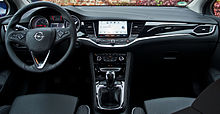
Opel officially unveiled the Astra K on 1 June 2015 and made its official premiere at the Frankfurt Motor Show in September 2015.[71]
The Astra K is smaller (5 cm), and lighter (up to 200 kg) compared to Astra J. Although it is smaller on the outside, Opel claims it is bigger on the inside than the previous Astra J. Depending on the model and trim level it is up to 200 kilograms - at the very least 120 kilograms - lighter than its predecessor. The completely new vehicle architecture plays a major role in the weight reduction. Every component was checked for compact design and lightweight materials. The bodyshell weight alone was reduced by 20 per cent from 357 to 280 kilograms. Additional, chassis-related measures resulted in another 50 kilograms of weight reduction; these include high-strength and ultra-high-strength low-weight steels, compact subframes as well as weight reductions to the front and rear axle. Rear suspension is torsion beam (only with Watts linkage on top engines), and MacPherson struts at the front.
Available engines at launch were 1.0-litre three-cylinder and 1.4-litre four-cylinder petrol engines or 1.6-litre diesels. It will be available with new full-LED front light techniques, A screen in the dash which connect to Android or iPhone comes as standard. This system is already available, in both the Corsa E and Adam.
Engines
[edit]Engines are available with the 5-speed or 6-speed manual transmission, and the newly developed 5-speed EasyTronic 3.0 automated manual, which is only available for the 1.0T SIDI engine. The only other available automatic transmission, at the beginning of production, is the 6-speed with active select mode, which can be ordered in late 2015, for the 1.4 SIDI Turbo with 150 PS, and 1.6 CDTI with 136 PS. Buyers can choose the Start/Stop system for all engines as an extra feature, except the 1.0T which will have system as standard.
All engines are new and recently developed by Opel - 1.0T SIDI, 1.4T SIDI (which sees its debut in the Astra K in 2015)[72] and the naturally aspirated version of it (which will be available later in 2015), and the so-called "Whisper diesel" 1.6 CDTI. All turbocharged petrol engines use the Direct Injection Fuel system.[73]
Opel are offering the ecoFLEX range for 1.0T, 1.4T and 1.6 CDTI engines which have same amount of power, but less CO2-emissions (g/km) and lower fuel consumption. The entire ecoFLEX range have Start/Stop as standard, low rolling resistance tyres and aerodynamic tweaks for reduced drag for lower CO2-emissions. The 1.4T SIDI ecoFLEX version have less torque, rated at 230 N⋅m (170 lbf⋅ft) at 2.000-4.000 rpm.
In 2019 Opel announced the move to the new GM E-Turbo 1.2-litre, "1.4-litre" (actually a 1.3-litre) three-cylinder petrol engines, and 1.5-litre three-cylinder diesels.[74]
Facelift
[edit]A facelift of Opel Astra K released around the summer of 2019. Changes were minimal, both inside and outside; however the facelifted Astra sports a new front grille, new rear lights, as well as a new windscreen wiper mechanism, where both wipers are individually controlled as opposed to a linked setup as before.
The last Astra to be produced in Ellesmere Port rolled off the assembly line on December 13, 2021.[75] The last Astra to be produced in Gliwice factory rolled off the assembly line on November 30, 2021.[76]
-
Facelift (hatchback)
-
Estate (facelift)
| Petrol engines | |||||||
|---|---|---|---|---|---|---|---|
| Model | Engine | Displacement | Power | Torque | Note | CO2 emissions | Years |
| 1.0T SIDI S/S | I3 | 999 cc | 105 PS (77 kW; 104 hp) at 5000 rpm | 170 N⋅m (125 lb⋅ft) at 1800-4250 rpm | 102-96 g/km | 2015-2019 | |
| 1.4 | I4 | 1399 cc | 100 PS (74 kW; 99 hp) at 6000 rpm | 130 N⋅m (96 lb⋅ft) at 4400 rpm | 124 g/km | ||
| 1.4 SIDI Turbo | 110 PS (81 kW; 108 hp) at 5600 rpm | 200 N⋅m (148 lb⋅ft) at 2000-3600 rpm | CNG/Petrol | 113 g/km | |||
| 125 PS (92 kW; 123 hp) at 5600 rpm | 245 N⋅m (181 lb⋅ft) at 2000-3500 rpm | 114-129 g/km | |||||
| 150 PS (110 kW; 148 hp) at 6000 rpm | 245 N⋅m (181 lb⋅ft) at 2000-3500 rpm | 128-124 g/km | |||||
| 1.6 SIDI Turbo S/S | 1,598 cc | 200 PS (147 kW; 197 hp) at 4,700-5,500 rpm | 280 N⋅m (207 lb⋅ft) at 1,650–3,500 rpm; overboost 300 N⋅m (221 lb⋅ft) at 1,700–4,700 rpm |
139-142 | |||
| 1.2 Turbo | I3 | 1199 cc | 110 PS (81 kW; 108 hp) at 4500 rpm | 195 N⋅m (144 lb⋅ft) at 2000-3500 rpm | 6-speed manual | 105-99 g/km | 2019- |
| 130 PS (96 kW; 128 hp) at 5500 rpm | 225 N⋅m (166 lb⋅ft) at 2000-3500 rpm | 104-99 g/km | |||||
| 145 PS (107 kW; 143 hp) at 5500 rpm | 225 N⋅m (166 lb⋅ft) at 2000-3500 rpm | 105-99 g/km | |||||
| 1.4 Turbo S/S | 1342 cc | 236 N⋅m (174 lb⋅ft) at 1500-3500 rpm | 7-Speed CVT automatic transmission | 116-114 g/km | |||
| Diesel engines | |||||||
| Model | Engine | Displacement | Power | Torque | Note | CO2 emissions | Years |
| 1.6 CDTI | I4 | 1,598 cc | 95 PS (70 kW; 94 hp) at 3,500 rpm | 280 N⋅m (207 lb⋅ft) at 1500–1750 rpm | 97-95 g/km | 2015-2019 | |
| 110 PS (81 kW; 108 hp) at 3500 rpm | 300 N⋅m (221 lb⋅ft) at 1750–2000 rpm | 97-90 g/km | |||||
| 136 PS (100 kW; 134 hp) at 3500-4000 rpm | 320 N⋅m (236 lb⋅ft) at 2000–2250 rpm | 103-99 g/km | |||||
| 1.6 CDTI Bi-Turbo | 160 PS (118 kW; 158 hp) at 4000 rpm | 350 N⋅m (258 lb⋅ft) at 1500-2250 rpm | 110-107 g/km | ||||
| 1.5D CDTI S/S | I3 | 1496 cc | 105 PS (77 kW; 104 hp) at 3250 rpm | 260 N⋅m (192 lb⋅ft) at 1500-2500 rpm | 6-speed manual | 94-90 g/km | 2019- |
| 122 PS (90 kW; 120 hp) at 3500 rpm | 300 N⋅m (221 lb⋅ft) at 1750-2500 rpm | 96-92 g/km | |||||
| 285 N⋅m (210 lb⋅ft) at 1500-2750 rpm | 9-speed automatic | 114-109 g/km | |||||
Safety
[edit]| Test | Points | % |
|---|---|---|
| Overall: | ||
| Adult occupant: | 32.9 | 86% |
| Child occupant: | 41.2 | 84% |
| Pedestrian: | 30 | 83% |
| Safety assist: | 9.8 | 75% |
Sixth generation (Astra L – C02; 2021)
[edit]| Sixth generation (Astra L) | |
|---|---|
 Opel Astra PHEV | |
| Overview | |
| Model code | C02 |
| Also called | Vauxhall Astra (United Kingdom) |
| Production | May 2021–present |
| Model years | September 2021–present |
| Assembly | Germany: Rüsselsheim |
| Designer | Ilka Höbermann (color and trim designer)[78] |
| Body and chassis | |
| Body style |
|
| Platform | PSA EMP2 platform |
| Related | DS 4 II Peugeot 308 III |
| Powertrain | |
| Engine |
|
| Electric motor | Synchronous Electric Motor (Astra Hybrid) |
| Transmission | 6-speed manual 8-speed automatic |
| Hybrid drivetrain | PHEV (Astra Hybrid) |
| Dimensions | |
| Wheelbase | 2,675 mm (105.3 in) (hatchback) 2,730 mm (107.5 in) (station wagon) |
| Length | 4,374 mm (172.2 in) (hatchback) 4,640 mm (182.7 in) (station wagon) |
| Width | 1,860 mm (73.2 in) |
| Height | 1,441 mm (56.7 in) |
The sixth generation Astra was unveiled on 13 July 2021 and it went on sale on 12 November 2021.[79] As the first Astra developed by PSA Group,[5] it’s based on the third-generation of the EMP2 platform which made its wheelbase grow by 55 mm (2.2 in). Launched ten months after the merger of FCA and PSA to form Stellantis, the vehicle has been offered as a hybrid for the first time and will unveil a 180-horsepower engine. The 225 horsepower version, taken from the Peugeot 508 and Peugeot 3008, is also available on the GSe version.[80]
-
Hatchback (PHEV)
-
Sports Tourer
-
Interior
| Petrol engines | |||||||
|---|---|---|---|---|---|---|---|
| Model | Name | Displacement | Power | Torque | Note | CO2 emissions | Years |
| 1.2 Turbo | EB2ADT | 1199 cc I3 | 110 PS (81 kW; 108 hp) at 5500 rpm | 205 N⋅m (151 lb⋅ft) at 1750 rpm | 6-speed manual | 123 g/km | 2022- |
| EB2DTS | 130 PS (96 kW; 128 hp) at 5500 rpm | 230 N⋅m (170 lb⋅ft) at 1750 rpm | 6-speed manual or 8-speed automatic | 123-126g/km | |||
| 1.6 Turbo PHEV | EP6FDT | 1598 cc I4 | 180 PS (132 kW; 178 hp) at 4250 rpm | 360 N⋅m (266 lb⋅ft) at 1500-3000 rpm | 8-speed automatic
Values given are for the whole drivetrain (PHEV) |
22 g/km | |
| 1.6 Turbo PHEV (GSe) | EP6FDT | 1598 cc I4 | 225 PS (165 kW; 222 hp) | 360 N⋅m (266 lb⋅ft) | 8-speed automatic
Values given are for the whole drivetrain (PHEV) |
||
| Diesel engines | |||||||
| Model | Name | Displacement | Power | Torque | Note | CO2 emissions | Years |
| 1.5 D | DV6 TED4 | 1499 cc I4 | 130 PS (96 kW; 128 hp) at 3750 rpm | 300 N⋅m (221 lb⋅ft) at 1750 rpm | 6-speed manual or 8-speed automatic | 113-117 g/km | 2022- |
Electric
[edit]In November 2022, the Opel / Vauxhall Astra Electric debuted with a 154 hp (115 kW) motor and a range of 258 mi (415 km).[81][82]
Safety
[edit]| Test | Points | % |
|---|---|---|
| Overall: | ||
| Adult occupant: | 30.7 | 80% |
| Child occupant: | 41.2 | 82% |
| Pedestrian: | 36.4 | 67% |
| Safety assist: | 10.6 | 66% |
Motorsport
[edit]
An Astra won the Andros Trophy for three consecutive years starting in 2000.
The Astra Coupé in BTC-T form was dominant in the British Touring Car Championship from 2001 until 2004, and it continued to compete in the series until 2006.
An Astra was used in the 1994 Super Tourenwagen Cup season. In 2002, 2003 and 2006, three different drivers were European Rallycross Champions in the Division 2 driving Astras. The 2003, 2004, 2006, 2007 and 2008 runners-up also raced in that car. Christian Ledesma was 2004 TC 2000 champion with an Astra and Matías Rossi took that title in 2006 and 2007.
A rally version of the Astra was built to the FIA 2-Litre World Rally Cup. The car finished second in class on the 1998 Rally of Great Britain, and claimed the British Rally Championship for manufacturers in 2000.

The Astra has been used in the shape of silhouette racing cars as well. It was featured in the Deutsche Tourenwagen Masters from 2000 to 2003 (Manuel Reuter was runner-up in 2000) and overall winner of the 2003 Nürburgring 24h race and the Stock Car Brasil from 2004 to 2008 (Giuliano Losacco won the tournament in 2004 and 2005). In 2009, the Astra G body was replaced Stock Car Brasil by a Vectra, which is in fact the same as the Astra H.
The car has also been raced in the Russian Touring Car Championship, the 2004 European Touring Car Championship season, the 2006 Swedish Touring Car Championship season, the 2008 European Touring Car Cup and the 2013 European Rallycross Championship season.
Latin American models (1994–2011)
[edit]Chevrolet Astra
[edit]The Chevrolet Astra is the same vehicle as the Opel Astra, but with some mechanical differences. In Brazil, Chevrolet Astra as launched at 1994 as 1995 model only in 5-door hatchback and station wagon body styles. It was available only in the GLS trim level with a 2.0-litre, eight-valve multipoint fuel injection engine with a power of 116 PS (85 kW). The plan was to replace the Chevrolet Kadett, an Opel Kadett E built locally, but an increase in taxes for import cars (from 35 to 70 per cent) made General Motors of Brazil stop importing the model for the 1996 model year. The Chevrolet Astra only returned in 1998, in second generation and built locally. Initially, it only came in 3-door hatchback and 4-door sedan body styles, and GL and GLS trim levels. The engine options were a 1.8 litre with 110 PS (81 kW) and a 2.0 litre with 112 PS (82 kW), both with 8 valves. Later models received the option of a 2,0 litre 16 valve engine, initially with a power of 128 PS (94 kW) and later yet with 136 PS (100 kW).
In 2003 the Astra range received an exterior facelift, with a 5-door hatchback completing the range. The 1.8 litre engine was discontinued, with a 2.0 litre flexfuel (ethanol and petrol) being launched for the 2004 model year. The 2.0 FlexFuel power was 121–128 PS (89–94 kW) depending on the fuel used; later this changed to 133–140 PS (98–103 kW). A GSI 2.0 16V was launched with the 2003 facelift and produced until 2005. The range did not change much until its discontinuation in 2011, being in effect replaced by the Chevrolet Sonic and Cobalt.
- Chile
In Chile, the Astra was sold under the Opel brand until 1997 (replacing the Kadett); beginning in 1999 the second generation was imported from Brazil under the Chevrolet brand. The third generation was again imported from Europe in and in 2017 it returned to be sold under Opel brand.
-
First generation
-
Second generation (pre-facelift)
-
Second generation (facelift)
-
Third generation (Chile)
Chevrolet Astra OPC and GSi
[edit]-
Chevrolet Astra GSi (pre-facelift)
-
Chevrolet Astra GSi (facelift)
-
Chevrolet Astra OPC (Chile)
Chevrolet Vectra (Brazil)
[edit]The Opel Astra H was sold in Brazil and Argentina between 2006 and 2011, as Chevrolet Vectra and Vectra GT (hatchback), replacing Vectra B. It shared the powertrain and the platform with the Astra G, except when equipped with the 2.4 engine, and it was inserted above the Astra in both markets. It was replaced by the flagship versions of the Chevrolet Cruze.
-
Hatchback (pre-facelift)
-
Hatchback (facelift)
-
Sedan
Notes
[edit]- ^
- General Motors (1992–2017)
- PSA Group (2017–2021)
- Stellantis (2021–present)
References
[edit]- ^ "Opel to launch in Australia". carsguide.com.au. Retrieved 22 May 2011.
- ^ "Opel abandons Australian arm after less than a year after poor sales". Dailytelegraph.com.au. Retrieved 27 December 2013.
- ^ "Opel to Build Vehicles for Holden in Australia and New Zealand". media.gm.com. Retrieved 14 July 2015.
- ^ Carscoops (May 2014). "Holden to Bring Astra VXR, Cascada and Insignia VXR to Australia and New Zealand". Carscoops. Retrieved 14 July 2015.
- ^ a b Radu, Mihnea (16 March 2021). "2022 Opel Astra Shows New Face of German Hatchbacks in Accurate Rendering". autoevolution. Retrieved 13 October 2021.
- ^ "PSA Group purchase of Opel and Vauxhall completed with new financial company". Autocar. Retrieved 13 October 2021.
- ^ "Here's how PSA will turn Vauxhall around by 2020". Top Gear. 9 November 2017. Retrieved 13 October 2021.
- ^ "GM Bakal Buka Lagi Pabrik Perakitan di Pondok Ungu". detikoto (in Indonesian). Retrieved 14 June 2022.
- ^ Söderlind, Alrik (5 September 1991). "Vill ni se en stjärna?" [Would you like to see a star?]. Teknikens Värld (in Swedish). Vol. 43, no. 17. Stockholm, Sweden: Specialtidningsförlaget AB. pp. 11–12.
- ^ Söderlind, Alrik (5 September 1991). "Vill ni se en stjärna?" [Would you like to see a star?]. Teknikens Värld (in Swedish). Vol. 43, no. 17. Stockholm, Sweden: Specialtidningsförlaget AB. pp. 11–12.
- ^ Danish Army Vehicles, 2024
- ^ Nouvelle, L'Usine (16 July 1998). "L'industrie polonaise monte en puissance". L'Usine Nouvelle (in French).
- ^ "'09 SA Car of Year named at Jozi banquet bash". IOL. 17 March 2009.
- ^ Opel Kadett 200tS, CAR, September 1995
- ^ Samahá, Fabrício. "Chevrolet Kadett". Carros do Passado [Cars of Yesteryear] (in Portuguese). Best Cars Web Site. p. 6. Archived from the original on 15 November 2012. Retrieved 2 November 2012.
- ^ Ward's World Motor Vehicle Data, Ward's Communications, 2001, page 239
- ^ Binder, Alan K.; Ferris, Deebe, eds. (2000). General Motors in the Twentieth Century. Southfield, MI: Ward's Communications. p. 151. ISBN 0-910589-52-6.
- ^ Chevrolet Astra GLS, um Belga naturalizado brasileiro que chegou disposto a enfrentar os alemães e italianos, Oficina Brasil, 10 August 2015
- ^ "Opel. Opel In Italy". Car-cat.com. Retrieved 2 October 2010.
- ^ "Opel. Opel In South Africa". Car-cat.com. Archived from the original on 8 July 2011. Retrieved 2 October 2010.
- ^ "History". ukravto.ua. Ukrainian Motor Corporation. Retrieved 25 December 2015.
2004 Opel Astra Classic motor car was put into serial production. UkrAVTO Corporation initiated Capital (Stolychne) Autoshow annual project.
- ^ "Ошибка 404 .. - GM-press.com // обзоры автомобилей, новинки автопрома, советы автомобилистам,курьезные случаи, аварии". Archived from the original on 10 March 2011. Retrieved 14 July 2015.
- ^ Valeria, Marco (4 June 2005). "Chevrolet arremete en la venta de modernos taxis" [Chevrolet blasts sales of modern taxis] (in Spanish). Las Últimas Noticias. Archived from the original on 16 February 2006. Retrieved 25 December 2015.
- ^ "Ediciones Especiales – El Mercurio". Edicionesespeciales.elmercurio.com. Retrieved 1 May 2009.
- ^ a b c "Expert online, March 19, 2008". Expert.ru. Archived from the original on 11 August 2010. Retrieved 2 October 2010.
- ^ "Autoreview, No. 3, 2008". Autoreview.ru. Retrieved 2 October 2010.
- ^ "Newsru.com, July 29, 2005". Newsru.com. 29 July 2005. Retrieved 2 October 2010.
- ^ https://cdn.euroncap.com/media/9759/euroncap_opel_astra_1999_4stars.pdf
- ^ "Der letzte Astra". RuhrNachrichten.de. 28 April 2014. Retrieved 22 February 2015.
- ^ "Opel Astra III NB – zakończenie produkcji". Automotiveblog.pl. 11 July 2014. Archived from the original on 15 March 2015. Retrieved 22 February 2015.
- ^ Satyam. "Welcome to GMArabia.com". Gmegypt.com. Archived from the original on 9 August 2010. Retrieved 2 October 2010.
- ^ "Guide to assembly plants in Europe" (PDF). automotivenews.com. Automotive News Europe. Retrieved 27 January 2022.
- ^ "Friedhelm Engler". Cardesigncontest.com. Archived from the original on 14 January 2012. Retrieved 14 November 2012.
- ^ "Not global: Opel out of GM Delta". Automotive News. 11 February 2002.
- ^ Ciferri, Luca (20 June 2002). "Fiat, General Motors developing joint Stilo-Astra platform". autoweek.com. Retrieved 6 November 2015.
- ^ "Motoring: Opel Astra 4-door for your eyes only". Sunday Mirror. 9 March 2008.
- ^ Homola, Peter (23 August 2007). "GM Launches Opel Astra Sedan Output in Poland". WardsAuto.com. Archived from the original on 19 November 2008. Retrieved 30 January 2008.
- ^ "Autoreview, March 2008". Autoreview.ru. Archived from the original on 9 August 2010. Retrieved 2 October 2010.
- ^ "Holden Astra TwinTop - Drive".
- ^ "2.2-Litre Engine Drives Astra TwinTop and SRi Models - Next Car Pty Ltd - 11th May, 2007".
- ^ Graham, Alex (28 February 2012). "Suppliers to the new Opel Astra TwinTop". Automotive News Europe. Crain Communications, Inc.
- ^ "Saturn's next Opel: 2008 Astra". AutoWeek. Archived from the original on 29 June 2011. Retrieved 7 December 2006.
- ^ "Inside Line: 2007 Chicago Auto Show: Saturn Takes the Wraps off Euro-Flavored 2008 Astra". Edmunds.com. Archived from the original on 10 February 2007. Retrieved 8 February 2007.
- ^ Gastelu, Gary (8 May 2008). "2008 Saturn Astra 3-Door XR". Fox News. Archived from the original on 10 May 2008. Retrieved 8 May 2008.
- ^ "Saturn Astra XR". Autoweek. Archived from the original on 29 June 2011. Retrieved 28 December 2007.
- ^ "IIHS-HLDI: Saturn Astra". Iihs.org. Archived from the original on 4 September 2009. Retrieved 1 May 2009.
- ^ "GM Media Online". Media.gm.com. 5 January 2009. Archived from the original on 23 April 2009. Retrieved 1 May 2009.
- ^ "2009 Saturn Astra Sales Figures". carfigures.com. Retrieved 7 October 2021.
- ^ "2009 Saturn Astra Specs and Features - MSN Autos". MSN Autos. 11 August 2009. Archived from the original on 2 March 2012. Retrieved 11 August 2009.
- ^ https://cdn.euroncap.com/media/10052/euroncap_opel_astra_2004_5stars.pdf
- ^ "Opel Astra: design story". Car Body Design. 23 June 2009. Retrieved 14 November 2012.
- ^ "Car News Blog: 2010 Opel Astra to debut at Frankfurt". Automobile mag. 8 September 2008. Archived from the original on 2 January 2013. Retrieved 21 October 2008.
- ^ "Opel Astra J Gebrauchtwagen kaufen und verkaufen bei AutoScout24" [Opel Astra J used cars for sale or to sell] (in German). AutoScout24. Archived from the original on 23 June 2015. Retrieved 5 June 2015.
- ^ "New Opel Astra chassis boosts dynamics, handling and comfort". Media.gm.com. 10 July 2009. Retrieved 25 June 2011.[permanent dead link]
- ^ "Bosch Media Service" (in German). Bosch-presse.de. Retrieved 14 November 2012.
- ^ "Bosch Media Service" (in German). Bosch-presse.de. Retrieved 14 November 2012.
- ^ "New Car Reviews – Opel Astra saloon". Carzone.ie. Retrieved 27 December 2013.
- ^ "New Opel Astra 4-door - the elegant compact saloon car - Opel Malta". opel.com.mt. Archived from the original on 15 July 2015. Retrieved 14 July 2015.
- ^ "What a stunner! Astra booted". Wheels24. Retrieved 24 July 2014.
- ^ "Opel Media – Europe – Company". media.gm.com. Retrieved 14 July 2015.
- ^ "Compare Models - Vauxhall GTC - Vauxhall". www.vauxhall.co.uk.
- ^ Opel Astra GTC (in German). Adam Opel AG. 2014 – via Veikl."Auto Prospekt Opel GTC 2015". eBay Kleinanzeigen (in German). Retrieved 14 April 2022.
- "Vauxhall Astra GTC range brochure 2014 Ed 1". eBay. Retrieved 14 April 2022.
- GTC (PDF) (2015 Models Edition 3 ed.). General Motors UK Limited. February 2015.
- ^ Sheehan, Sam (15 June 2018). "Vauxhall Zafira Tourer and GTC axed due to rise of SUVs". Autocar.
- ^ "Vauxhall GTC - Choose Trim, Engine & Options". vauxhall.co.uk.
- ^ "Opel Media – Europe – News". Media.opel.com. Retrieved 14 November 2012.
- ^ "Premiere in Geneva: Opel Astra 1.6 CDTI Needs Just 3.7 Liters Diesel". media.opel.de. Retrieved 5 February 2014.
- ^ "The new Opel Astra line-up: More variety, engines and high-tech features". Media.opel.com. 15 June 2012. Retrieved 14 November 2012.
- ^ https://cdn.euroncap.com/media/7507/euroncap_opel_astra_2009_5stars.pdf
- ^ US D788645, Mueller, Uwe, "Motor car", published 2017-06-06, assigned to GM Global Technology Operations LLC
- ^ Panait, Mircea (1 June 2015). "2015 Opel Astra K is Here to Stay". autoevolution. Retrieved 1 August 2024.
- ^ "Pure Pleasure: Highly Efficient 1.4-Liter Turbo in the New Astra". Media.opel.com. Retrieved 17 June 2015.
- ^ "Affordable High-Tech: New Opel Astra Tough on CO2 and Prices". Media.opel.com. Retrieved 12 June 2015.
- ^ "Five power units under 100g CO2: New Opel Astra Available to Order". Media.opel.com. 21 August 2019. Retrieved 19 July 2020.
- ^ "Final British-built Vauxhall Astra rolls off Ellesmere Port production line". 7 April 2022.
- ^ "E-vans drive hopes as Opel ends Polish Astra production". Deutsche Welle. Retrieved 30 November 2021.
- ^ https://cdn.euroncap.com/media/67698/euroncap-2015-opel-vauxhall-astra-datasheet.pdf
- ^ "Full of Emotions: Different Development Approach for New Opel Astra". Stellantis. 29 September 2021. Retrieved 20 June 2022.
- ^ "2022 Opel Astra Revealed With Sharp Look, Diversified Powertrains". Motor1.com. Retrieved 13 July 2021.
- ^ "2022 Opel Astra Has Stellantis Underpinnings And A Bold New Face". Carscoops. 13 July 2021. Retrieved 13 July 2021.
- ^ Parras, Thanos (30 November 2022). "2023 Opel / Vauxhall Astra Electric Debuts With 154 Hp And A 258-Mile Range". Carscoops. Retrieved 4 December 2022.
- ^ Padeanu, Adrian. "2023 Opel Astra Electric Hatch, Wagon Debut With 258 Miles Of Range". Motor1.com. Retrieved 4 December 2022.
- ^ https://cdn.euroncap.com/media/69580/euroncap-2022-opel-vauxhall-astra-datasheet.pdf













